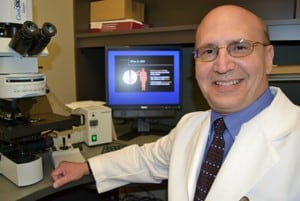UAMS’ Drew Coauthors Promising M.S. Discovery
June 1, 2011 | The prestigious journal Nature has published research coauthored by UAMS’ Paul D. Drew, Ph.D., of a promising new compound for treating multiple sclerosis and other autoimmune diseases. “This is an encouraging potential therapy because it involves a novel, targeted approach,” Drew said. Autoimmune diseases attack the body’s tissues. Multiple sclerosis attacks the central nervous system. Traditional treatments have relied on suppressing patients’ entire immune systems, so finding a treatment that specifically targets the disease would be a major breakthrough. “Our immune system is there for a reason, so there are consequences to the current therapies that suppress it,” Drew said. “When the immune system is compromised by drugs that suppress it, patients are more prone to infections and even cancer.” The study of the new compound, known as SR1001, was led by Tom Burris, Ph.D., at the Florida campus of The Scripps Research Institute. Although the compound showed promise in cells, Burris needed to demonstrate it in animal studies, so he turned to Drew, whose research is funded by the National Institutes of Health (NIH) and the National Multiple Sclerosis Society. Drew’s University of Arkansas for Medical Sciences collaborators and coauthors on the Nature publication are Jihong Xu, Ph.D., and Gail Wagoner. Their research confirmed that the new compound helped suppress the severity of disease in an animal model of multiple sclerosis. Drew noted that the compound blocks the actions of a specific cell type that plays a significant role in autoimmunity, meaning it has potential to treat other autoimmune diseases such as rheumatoid arthritis, lupus and inflammatory bowel disease. The discovery of the new compound and its effectiveness against autoimmune diseases has been published in the April 17, 2011, advance online edition of Nature. It appeared in the regular April 28 issue of the journal. Although the discovery of SR1001 is worthy of excitement, Drew said it is important to note that the research is still in its earliest stages. In addition to his research, Drew has extensive experience reviewing multiple sclerosis-related grant applications. He is a full member of the NIH CSR Clinical Neuroimmunology and Brain Tumors and the National Multiple Sclerosis Society Biomedical Research Committee A study sections. |
